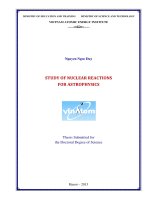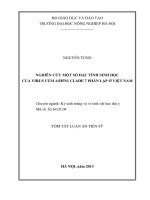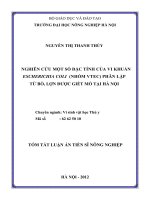Luận án tiến sĩ nghiên cứu một số phản ứng hạt nhân cần thiết cho thiên văn học
Bạn đang xem bản rút gọn của tài liệu. Xem và tải ngay bản đầy đủ của tài liệu tại đây (6.01 MB, 153 trang )
MINISTRY OF EDUCATION AND TRAINING
MINISTRY OF SCIENCE AND TECHNOLOGY
VIETNAM ATOMIC ENERGY INSTITUTE
------
------
Nguyen Ngoc Duy
STUDY OF NUCLEAR REACTIONS
FOR ASTROPHYSICS
Thesis Submitted for
the Doctoral Degree of Science
Hanoi – 2013
MINISTRY OF EDUCATION AND TRAINING
MINISTRY OF SCIENCE AND TECHNOLOGY
VIETNAM ATOMIC ENERGY INSTITUTE
------
------
Nguyen Ngoc Duy
STUDY OF NUCLEAR REACTIONS
FOR ASTROPHYSICS
Subject: Atomic and Nuclear Physics.
Code number: 62 44 05 01
Thesis Submitted for
the Doctoral Degree of Science
Thesis Supervisors
1. Ass.Prof. Le Hong Khiem
2. Ass.Prof. Vuong Huu Tan
Hanoi - 2013
Statement of authorship
I hereby certify that the present dissertation is my own research
work under guidance of my supervisors. All the data and results
presented in this dissertation are true and correct. They are based on
the results and conclusions of eleven papers written in coauthorship with my collaborators. All of them have been published
in peer-review journals and science reports. These results have also
been reported at European Nuclear Physics Conference 2012 and
seminars in Romania, Japan and Vietnam. This approbation process
guarantees that these results have never been published by anyone
else in any other works or articles. Some results from other studies
used to compare and discuss with our new data are noted clearly as
references.
Nguyen Ngoc Duy
i-1
Acknowledgements
First, I would like to thank my supervisors in Vietnam, Ass.Prof. Le Hong
Khiem and Ass.Prof. Vuong Huu Tan. They are my good supervisors since they
are always able to give me kind suggestions and talk with me like a friend. As
the supervisors, they are very kind to give me scientific knowledge. They give
me a chance to go abroad to study at many classes and attend many wonderful
conferences. They teach and direct me carefully to complete this thesis.
Second, I would like to give my deeply thank to my supervisor in Japan,
Prof. Dr. Shigeru Kubono at the University of Tokyo. He is not only a famous
scientist but also a very kind supervisor. He always very nicely gives me clear
and patient guidance that helps me to conduct my research. He supports me in
science as well as finance to study and perform the experiment of this work
during I stay in Japan.
I also owe my thanks to Dr. Pham Dinh Khang, Ass.Prof. Nguyen Nhi
Dien and Dr. Phu Chi Hoa who give me many meaningful advices and help me
to finish the PhD course. Thanks to their kind encouragement and organization
for the thesis committee.
It would be inappropriate not to mention Dr. Nguyen Xuan Hai, Dr. Dam
Nguyen Binh and Mr. Nguyen Duy Ly for their kind discussion. I must
emphasize their readiness to share their knowledge and experience.
I would also like to thank all of our collaborators at the CRIB facility for
their help to perform my experiment successfully. I especially thank Dr.
Hidetoshi Yamaguchi and David Miles Kahl at CNS who helped me with their
best efforts during the beam time.
Last but not least, I thank my family and my friends for supporting me all
the time. This thesis is as a present sent to my lovely departed father. Although
he was very sore because of cancer, during his hospital time, he encouraged me
a lot.
i-2
Symbols and abbreviation
List of Symbols and Abbreviations
ADC
: Analoge – Digital Converter.
CAMAC
: Computer Automated Measurement and Control.
cm
: centimeter.
enA
: electron-nanoAmpere.
eµA
: electron-microAmpere.
FADC
: Flash ADC.
Fm
: Fermi (10-15 m).
g
: gram.
GK
: Giga Kelvin (109 K)
GSI
: The GSI Helmholtz Centre for Heavy Ion Research.
GEM
: Gas-Electron Multiplier.
HDD
: Hard disk.
JINA
: Joint Institute for Nuclear Astrophysics-Michigan State University
K
: temperature scale Kelvin.
k
: Boltzman constant.
keV
: kilo-electron-Volt.
kHz
: kilo Hertz.
kV
: kilo-Volt.
MΘ
: Solar mass.
MeV
: Mega-electronVolt.
MeV/u
: Mega-electronVolt per nucleon.
i-3
Symbols and abbreviation
MHz
: Mega-Hertz.
MK
: Mega-Kelvin (106 K)
mm
: millimeter.
msr
: mili-steradian.
mV
: mili-Volt.
n
: neutron or the number of events.
nm
: nano-meter (10-9 m)
ns
: nano-second (10-9 s)
NSCL
: National Superconducting Cyclotron Laboratory (Michigan USA)
p
: proton.
pC
: pico-Coulomb (10-12 C).
ps
: pico-second (10-12 s).
PID
: Particle Identification.
q
: charge of particles.
RF
: Radio Frequency of accelerator.
RI
: Radioactive Ion.
s
: second.
sccm
: Standard Cubic Centimeters per Minute.
sr
: steradian (solid angle).
T
: temperature or Tesla.
T1/2
: half-life of isotopes.
T6
: temperature in the scale of 106
T9
: temperature in the scale of 109.
TDC
: time-to-digital converter.
Tm
: Tesla-meter (Magnetic field).
i-4
Symbols and abbreviation
torr
: unit of pressure (torricelli).
TRIUMF
: Canada's national laboratory for particle and nuclear physics.
V
: Volt.
v
: velocity.
VME
: Computer control interface for data acquisition of experiment.
α
: alpha particle (4He).
β
: Beta decay.
γ
: gamma-ray.
µ
: reduce mass of nuclear system.
µm
: micrometer = 10-6 m.
µs
: microsecond = 10-6 s.
ν
: neutrino.
π
: constant = 3.141516(15).
^
: AND logic.
yrs
: years.
amu
: atomic mass unit.
i-5
Contents
CONTENTS
Overview .............................................................................................................. 1
Chapter 1. Introduction ...................................................................................... 4
1.1. Origin of matter in the universe ..................................................................... 4
1.2. Nucleosynthesis on stars ................................................................................ 6
1.2.1. Hydrogen burning ....................................................................................... 6
1.2.2. Helium burning ......................................................................................... 10
1.2.3. Nucleosynthesis involving up to Fe .......................................................... 11
1.2.4. Nucleosynthesis involving beyond Fe ...................................................... 14
1.3. Type II Supernovae ..................................................................................... 16
1.4. X-ray Bursts ................................................................................................. 17
1.5. Motivation of the study of 26Si and 22Mg(α,α)22Mg scattering .................. 17
1.5.1. Reaction rate of 22Mg(α,p)25Al ................................................................. 18
1.5.2. Distribution of 26Al in the Galaxy............................................................. 19
1.5.3. Reaction rate of 25Al(p,γ)26Si .................................................................... 20
1.5.4. Nuclear structure of 26Si above α-threshold ............................................. 21
1.6. The goals of this work .................................................................................. 22
1.7. Stellar reaction rate....................................................................................... 23
1.7.1. Non-resonant reaction rate ........................................................................ 24
1.7.2. Resonant reaction rate ............................................................................... 26
1.7.2.1. Narrow resonance................................................................................... 27
1.7.2.2. Broad resonance ..................................................................................... 28
1.8. R-matrix method .......................................................................................... 29
Chaper 2. Experimental measurement of 22Mg + α reaction ........................ 31
2.1. Experimental method ................................................................................... 31
2.1.1. Estimation of the interest energy region ................................................... 31
2.1.2. Thick target in inverse kinematic mechanism .......................................... 32
2.1.3. CRIB spectrometer .................................................................................... 33
i-6
Contents
2.1.4. Particle detector ......................................................................................... 37
2.1.4.1. Beam monitor PPAC .............................................................................. 37
2.1.4.2. Design of the silicon-detector telescopes ............................................... 39
2.1.4.3. Design the active-gas-target detector GEM-MSTPC ............................ 41
2.2. Experimental setup ....................................................................................... 44
2.2.1. Setup of 22Mg + α reaction........................................................................ 44
2.2.2. Electronic system ..................................................................................... 47
2.3. Data Acquisition ........................................................................................... 49
2.4. Radioactive Ion beam production of 22Mg .................................................. 50
2.4.1. Estimation of the production reactions ..................................................... 50
2.4.2. 22Mg beam production ............................................................................... 51
Chapter 3. Data Analysis and Results. ............................................................ 55
3.1. Energy calibration ........................................................................................ 56
3.2. Particle Identification ................................................................................... 58
3.2.1. RI beam identification ............................................................................... 58
3.2.2. Ejectiles identification ............................................................................... 59
3.3. Energy loss correction .................................................................................. 61
3.4. Data analysis of 22Mg(α,α)22Mg .................................................................. 64
3.4.1. Analysis algorithm ................................................................................... 64
3.4.2. Computer codes for data analysis ............................................................. 67
3.4.3. Kinematics solution ................................................................................... 68
3.4.4. Energy uncertainty .................................................................................... 69
3.4.5. Solid angle ................................................................................................. 70
3.4.6. Beam events .............................................................................................. 72
3.4.7. Differential cross section and resonances ................................................. 72
3.5. R-matrix analysis for 22Mg(α,α)22Mg reaction ............................................ 75
3.6. Excited states above the alpha threshold of 26Si .......................................... 79
3.7. Rate of the stellar reaction 22Mg(α,p)25Al.................................................... 81
Conclusion and Outlook ................................................................................... 89
i-7
Contents
List of Publications ............................................................................................ 92
Bibliography ...................................................................................................... 94
Appendix
Appendix A: Energy calibration and Energy loss correction ........................... A-1
Appendix B: Several main computer codes which were used for data
analysis ....................................................................................... A-3
Appendix C: Geometry solution for scattering angles .................................... A-23
Appendix D: Transformation between the Laboratory and the Center-of-Mass
Frame ........................................................................................ A-26
Appendix E: A part of energy levels of 24Mg ................................................. A-28
Appendix F: The rate of the 22Mg+α interaction calculated by NON-SMOKER
code ........................................................................................... A-29
Appendix G: Several photos during this work ................................................ A-30
Appendix H: The proof of the experiment at CRIB facility ........................... A-32
i-8
List of figures
Figure 1.1. Abundance ratio of isotopes to Silicon (106) in the Solar system. ..... 5
Figure 1.2. Potential of
22
Mg and
22
Mg(α,p)25Al reaction in the hydrongen
burning via NeNa-MgAl cycles. ......................................................... 19
Figure 1.3. Nuclear level scheme of 26Si and its mirror nucleus, 26Mg .............. 21
Figure 1.4. Gamow window is as a result of high energies following Maxwellian
distribution and Coulomb barrier penentrability of particles. ............ 26
Figure 1.5. Resonant reaction is processed via compound mechanism. ............. 26
Figure 1.6. An enhance of the narrow resonance ............................................... 28
Figure 2.1. Illustration of excitation function measurement by using thick target
in inverse kinematics........................................................................... 32
Figure 2.2. A plane view of the CRIB separator................................................. 33
Figure 2.3. Design of the cryogenic gas target system at CRIB. ........................ 35
Figure 2.4. Side view of the Wien Filter structure .............................................. 36
Figure 2.5. Structure of the monitor PPAC. ........................................................ 38
Figure 2.6. An image of SSD with 16 strips is similar to the 8-strips SSD. ....... 39
Figure 2.7. Schematic of downstream telescopes (a) and side telescopes (b). ... 40
Figure 2.8. Main structure of the active-target detector GEM-MSTPC ............. 42
Figure 2.9. Schematic of proportional counter region with GEM foils and readout pad structure. ................................................................................. 42
Figure 2.10. Setup of the experiment using GEM-MSTPC ............................... 45
Figure 2.11. Top view of detector system inside the reaction chamber ............ 45
Figure 2.12. A diagram of electronic system for the experiment. ...................... 47
Figure 2.13. The diagram of electronic system for trigger and DAQ. The TDC
and ADC were installed in VME and CAMAC, while the Flash ADCs
COPPER were mounted in VME........................................................ 48
Figure 2.14. Timing chart of the coincident gate for out-put trigger. ................. 49
i-9
Figure 2.15. The yield of radioactive beam 22Mg is as a function of primary
beam current of 20Ne. The error bar (7%) indicate the fluctuation of
intensity of 22Mg due to small instability of 20Ne from the ion source
HyperECR ........................................................................................... 51
Figure 2.16. The plot shows particle identification at F2 based on time of flight
(ToF) and energy E from measured data (a) and simulation (b). It
points out that the 22Mg12+ can be distinguished easily from other
contaminants. ...................................................................................... 52
Figure 2.17. The histogram indicates X-position of the particles on the PPACa at
F3 plane. Here, the main contaminants are only primary beam 20Ne10+
and 21Na11+. We can distinguish the interested beam by RF signal and
energy at F3. ........................................................................................ 52
Figure 2.18. The beam was focused on the target at the F3 focal plane. ............ 52
Figure 3.1. Energy spectrum of triple-alpha source was measured by strip No.4.
The inset shows correlation between alpha energy and channel of the
calibration............................................................................................ 56
Figure 3.2. Calibration of high-gain region with triple-alpha source ................. 57
Figure 3.3. Calibration of low-gain region during experiment schedule with the
RI beam including 20Ne10+, 21Na11+ and 22Mg12+. ................................ 58
Figure 3.4. Bragg curves of 22Mg, 21Na and
20
Ne were measured by the active
target detector. The 22Mg12+ was gated by using the windows of ∆EPad number ......................................................................................... 59
Figure 3.5. Identification of ejectiles coming from the reaction by the ∆E-E
method ................................................................................................. 61
Figure 3.6a. The measured and calculated energy loss of 22Mg at 18.48 MeV
after passing through He+CO2 (10%) with different pressures. ......... 63
Figure 3.6b. The measured and calculated energy loss of alpha at 5.795 MeV
after passing through He+CO2 (10%) with different pressures. ......... 63
Figure 3.7a. Fitting curve of energy loss of 22Mg was measured and calculated
by SRIM2010. ..................................................................................... 64
i-10
Figure 3.7b. Fitting curve of energy loss of alpha which was measured and
calculated by SRIM2010..................................................................... 64
Figure 3.8. Data channels in each event which is needed to be extracted in the
algorithm ............................................................................................. 65
Figure 3.9. Gating 22Mg beam based on energy loss distribution in one pad ... 66
Figure 3.10. Schematic of the kinematic solutions. ............................................ 68
Figure 3.11. Energy uncertainty as a function of reaction energy at different
angles................................................................................................... 70
Figure 3.12. The illustration of solid angle determination in a given angular
range .................................................................................................... 71
Figure 3.13. The excitation function of the alpha scattering cross sections in
center-of-mass system at θlab = 0 - 5 degrees. ..................................... 73
Figure 3.14. The excitation function of the alpha scattering cross sections in
center-of-mass system at θlab = 5 - 10 degrees. ................................... 73
Figure 3.15. The best fitting curve by R-matrix analysis with Jπ of the first and
the last resonances are 2+ and 0+, respectively ................................... 78
Figure 3.16. Reaction rates of the stellar reaction
22
Mg(α,p)25Al calculated by
resonant states in 26Si from the alpha scattering measurement in the
energy region corresponding to stellar temperature of 1.0 - 2.5 GK.
The result which is out of the temperature range is extrapolation...... 83
Figure 3.17. Reaction rates for 22Mg(p,γ)23Al reported in ref [105] .................. 83
Figure 3.18. Reaction rates were calculated from the experimental cross sections
in this work (solid line) and from the statistical cross sections obtained
by NON-SMOKERWEB (dash line) ..................................................... 86
Figure 3.19. S-factor as a function of energy ...................................................... 87
Figure C.1. Geomertry of the detector setup ................................................... A-24
Figure C.2. A sketch of SSD telescopes including segments which are used to
calculate the scattering angles. ....................................................... A-24
Figure D.1. The relationship between laboratory and center-of-mass frames A-26
i-11
Photo G.1. Analog signal from readout pad of GEM-MSTPC. ...................... A-30
Photo G2. The production target vessel and liquid nitrogen bottle were being
prepared for the experiment at CRIB. ............................................. A-30
Photo G3. GEM-MSTPC inside F3 chamber.................................................. A-30
Photo G4. A part of electronic system for DAQ of the experiment. .............. A-31
Photo G5. Preparation for the experiment. ..................................................... A-31
i-12
List of tables
Table 1.1. A summary of pp-chain in Hydrogen burning process.. ...................... 7
Table 1.2. List of main reaction chains of hydrogen burning in CNO and Hot
CNO cycles............................................................................................................ 8
Table 2.1. Parameters of Gamow windows in the interest energy region .......... 31
Table 2.2. Details of CRIB design ...................................................................... 34
Table 2.3. Operating bias which were Alied to the GEM-MSTPC during the
experiment ........................................................................................... 46
Table 3.1. Energies of alpha emitted from the isotopes in the source ................ 56
Table 3.2. The calibrated parameters for the low- and high-gain regions. ......... 57
Table 3.3. The open channels of (22Mg + α) interaction at Ecm = 3.0 MeV ........ 59
Table 3.4. Fitting parameters of measurement and SRIM calculation ............... 63
Table 3.5. Format of the file containing parameters of each event..................... 65
Table 3.6. Relative energies of resonances obtained from the excitation function
of cross sections, which would be used to input into AZURE code .. 75
Table 3.7. The initial parameters of Eresonances for AZURE ........................... 77
Table 3.8. The initial parameters of the entrance channel for AZUR . .............. 77
Table 3.9. The resonant states in 26Si determined in this work were compared
with previous studies in ref [13] and ref [14]. .................................... 79
Table 3.10. Energy levels of 12C in range of 0 - 15 MeV .................................. 80
Table 3.11. Resonance strengths of resonances above alpha-threshold of 26Si .. 82
Table 3.12. Reaction rates of resonances calculated from the experimental cross
sections measured in this work ........................................................... 84
Table 3.13. Rates corresponding to speed of reactions of
22
22
Mg(p,γ)23Al,
Mg(α,p)25Al and beta decay. ............................................................ 85
Table 3.14. S-factor S(E) at the resonances were determined in this work ....... 88
i-13
Table A1. The parameters of the energy calibration for SSD strips. ................ A-1
Table A2.1. Energy loss of alpha measured and calculated by SRIM2010 was
used for the correction. ..................................................................... A-2
Table A2.2. Energy loss of 22Mg measured and calculated by SRIM2010 was
used for the correction. ..................................................................... A-2
Table C. A part of results of geometry calculation with the reaction points in the
middle of active target (pad number 23, 24). .................................. A-25
Table E. Apart of energy levels of 24Mg. ........................................................ A-28
Table F. The rate of the
22
Mg+α interaction calculated by NON-SMOKER
code ............................................................................................... A-29
i-14
Abstract
Abstract
Nuclear physics plays an important role in the improvement of the world.
There are many useful applications of the nuclear physics in industry,
agriculture, medicine, etc... Besides, nuclear physics is a powerful tool to study
astrophysics. Since all materials are constructed from nuclei, it is possible to
study stars, supernovae and cosmological phenomena by using nuclear reactions
in laboratories on the Earth. Therefore, the study of nuclear reactions is
important not only for physics but also for astrophysics, so-called nuclear
astrophysics. According to the cosmic observation and nuclear mechanisms, the
stellar evolution models including a lot of nuclear processes are supposed [1, 2].
There are many reaction chains during the nucleosynthesis in stars, which
include sensitive reactions at which the evolution can change its behavior to
grow upon other branches.
The implication of nuclear physics for astrophysics was thought to have
been taken place since the late of 1950s from the seminal works of Burbidge,
Burbidge, Fowler, and Hoyle in their famous paper [3] and independently by
Cameron[4]. However, these works were relied on theoretical prediction of
astronomy, astrophysics and nuclear physics. It is necessary to perform
experimental research to confirm the theory. There are many accelerator
facilities with modern spectrometers which were built for measurements of
nuclear astrophysics, such as TRIUMF [5] in Canada, JINA [6] and NSCL [7] in
the United States of America, CRIB [8] in Japan, GSI [9] in Germany, etc…In
Vietnam, a Tandem accelerator located at Hanoi University of Science is being
constructed to use for undergraduate training and study of nuclear astrophysics.
In the rp-process of the nucleosynthesis in Supernovae [10, 11] and X-ray
Bursts [12], the stellar reaction 22Mg(α,p)25Al is a significant link. This reaction
is very meaningful because it relates to not only the 26Si structure but also the
celestial phenomena as well as the experimental technique, as described in
1
Abstract
section 1.5. There were two efforts to study the rate of
22
Mg(α,p)25Al reaction
[13, 14]. However, the results are still uncertain since the observed data relied
on the beta decays of 26P or (p,t) reaction are far from the Gamow window (see
section 1.7), which corresponds to the temperature range of Supernovae and Xray Burst environments. The excited states of 26Si obtained by 26P could not be
used to calculate reaction rate of 22Mg(α,p)25Al in the temperature region T9 >1
GK because the energy levels are still low. The work in ref.[13] included a large
uncertainty above the alpha threshold of
26
Si since the reaction rate was
determined by the resonances that were assigned indirectly by using spinparities of the mirror nucleus, 26Mg. In addition, the S-factor [15] needed for the
reaction rate calculation was calculated from the quantum parameters of the
mirror nucleus. Because the information above the alpha threshold of
26
Si
corresponding to the region T9 > 0.5 GK seems to be empty up to date, the
calculated rates of the stellar reaction is still uncertain.
In such research scenario, we decided to perform a direct measurement of
the
22
Mg+α reaction by using CRIB facility located at RIKEN, Japan. The
reaction energy corresponded to the stellar condition of T9 > 0.5 GK. This work
investigated the
26
Si structure above the alpha threshold and the rate of the
stellar reaction 22Mg(α,p)25Al. Because the resonances of nuclei may be caused
by the cluster structure [16, 17, 18], the α-cluster structure of resonance states in
the 26Si nucleus was evaluated. For astrophysical aspects, the potential waiting
point of 22Mg in the nucleosynthesis [19], the existence of the gamma ray 1.275
MeV as well as the anomalies in the Ne-E problem [20, 21] and the abundance
of
22
Na in meteorites could be revealed based on the rate of
22
Mg(α,p)25Al
obtained in this study.
This dissertation is constructed by an overview, three chapters and the
conclusion. The general knowledge of nuclear physics, astrophysics and the
goals of this work are mentioned in the first chapter. The basic theory of the
stellar reaction rate and the R-matrix method used to determine reaction rate is
2
Abstract
also mentioned in this part. The second chapter is the details of the
22
Mg(α,α)22Mg experiment. In this chapter, the methods and the setup of the
experiment are mentioned. The RI beam production of
22
Mg is also reported
here. In the last chapter, we describe the analysis and discussion about the
results. This chapter contains the experimental data of
astrophysical implications for the stellar reaction
22
26
Si and their
Mg(α,p)25Al. The final
section of the thesis is the conclusion of the present study as well as the future
plan to continue doing research on the 22Mg+α interaction.
3
Chapter 1. Introduction
Chapter 1. Introduction
1.1.
Origin of matter in universe
The origin of matter is still an interest question of human history. There
were some hypotheses in the ancient world. According to Eastern philosophy,
the matter was built from five basic elements: metal (gold), wood, water, fire
and earth. Whereas, ancient Greece thought that all matters were created from
air, water, fire and earth. The ideas prove that people tried to explain the origin
of matter in the universe. And it is worth noting that in order to discover the
universe it is necessary to understand the origin of matter. More than 2400 years
ago, Democritus, a Greek philosopher, reasoned that a matter could not be
divided forever, it has a limit piece named “atomos”. His idea was similar to
another one supposed by Paramu, an Indian philosopher. They all thought that
matter, including planets and stars, should be constructed by a lot of small
pieces (atomos) by the time via different mechanisms. During the 18th and 19th
centuries, scientists fortified the ancients’ opinions via experiments in chemical
reactions. However, in the years at the end of the 19th century, ancient atomic
theory was changed when John Thomson discovered electrons in 1897. He
pointed out that the atom’s structure includes two kinds of smaller particles:
electrons and protons. Fifteen years later, Rutherford found out the atomic
nucleus and in 1932 Chadwick proved the existence of neutrons. The origin of
matter, now, is clearer in consideration.
Nowadays, by using a lot of instruments and high energy accelerators,
scientists discovered deeply inside the atom and the nucleus together with
particles which have a microscopic scale and “special” properties. In addition,
scientists study matter not only on the earth, in laboratories, but also in the
universe by observation and measurement. Astrophysicists demonstrate that the
universe is expanding [22] and there are a lot of cosmic rays including pions,
4
Chapter 1. Introduction
muons, positrons and neutrons. Such kinds of particles are also observed in
either nuclear reactions or particle collision in high energy accelerators.
accelerator
Therefore, cosmic rays
ray are the windows of the universe. The cosmological
observation indicates that we can study the universe
erse on the Earth, from the Sun
and stars, and nuclear
uclear physics is a key to access to the cosmos.
As mentioned above, matter on stars is also composed to atoms, nucleus
and particles via nucleosynthesis. One of the first taskss to understand the
formation and evolution of objects in the universe is to study the abundance of
isotopes in nature. By investigating the results that were recorded on the Earth,
the planets and the celestial objects, we can predict the coursee of their evolution.
As can be seen in Fig.11.1,, the abundance ratio of light elements to Silicon in the
Solar system is very high. In the mass region above Iron, abundance of isotopes
are also set as peaks at Fe, Ge, Sr, etc…These phenomenaa imply that in the
stars, nucleonsynthesis is still going on process. Therefore,
Therefore, study of the
nucleosynthesis inn stars plays
pla an important role in discovering the universe.
Figure 1.1. Abundance ratio of isotopes to Silicon (106) in the Solar system.
5
Chapter 1. Introduction
1.2.
Nucleosynthesis on stars
Nucleosynthesis after the Big Bang was proposed in 1930s by two famous
scientists, Bethe and Critchfield, since they discovered thermonuclear reaction
of four Hydrogens to produce a Helium particle. According to their model, the
nucleosynthesis can be divided into four main processes: Hydrogen burning,
Helium burning, element production up to Fe and isotope production beyond Fe.
1.2.1. Hydrogen burning
In the sense of one second after the Big Bang, the earliest nucleus built is
Hydrogen and the universe was filled with a large number of protons. In
addition, there are a lot of protons in the outer layers of stars. Under such
conditions, the fusion of four protons produces helium, so-called Hydrogen
burning.There are three main transformations from protons to Helium in
Hydrogen burning process: proton-proton chain (pp-chain), CNO cycles and
NeNa-MgAl cycle. Each kind of synthesis depends typically on the density,
temperature and catalyst of the stellar environments. For example, the process
occurs in the core of stars with the temperature in a range of 8-55 MK, while the
temperature in shells of AGB stars [23] is around 45 - 100 MK; for star mass M
lower than Solar mass MΘ, the pp-chain is dominant and, inversely, the
dominant is the CNO and NeNa-MgAl cycles.
Proton-proton chains (pp-chains)
The synthesis of Helium via pp-chain starts with two first steps:
1
1
H + 11H → 12 D + e+ + υe + 0.42MeV ,
2
1
D + 11H → 23 He + γ + 5.49MeV .
The chain is continued with one of three possible transformations in the latter
sense, which are named pp1, pp2 and pp3. Depending on the stellar temperature,
the second step bridges to other branches as shown in table 1.1. The probability
of pp1, pp2 and pp3 are 86%, 14% and 0.11% in the Sun, respectively.
6
Chapter 1. Introduction
Table 1.1. A summary of pp-chain in Hydrogen burning process.
3
pp1 chain
pp2 chain
pp3chain
p(p,e+υ)d
p(p,e+υ)d
p(p,e+υ)d
d(p,γ)3He
d(p,γ)3He
d(p,γ)3He
He(3He,2p)α
3
He(α,γ)7Be
7
3
He(α,γ)7Be
Be(e-,υ)7Li
7
7
8
Li(p,α)α
Be(p,γ)8B
B(β+υ)8Be
8
Be(α)α
The energy of Hydrogen burning is independent from details of
conversion. This process releases an energy of Q = 4mH - mHe = 26.731 MeV,
where mH and mHe are masses of proton and Helium, respectively. Depending on
the temperature of a star, energy released in such synthesis is distributed to
space outside stars into two main forms: photons and neutrinos. Photon emission
often occurs in the stars in which the temperature is approximately 1 GK and the
neutrino deliverance takes place in the stellar environment of 0.5 GK. The
fusion energy in a star prevents collapse due to its gravitation.
CNO cycles
In the scenario of the inner layers of stars, there are heavier elements,
such as Li, Be, B, C, N and O. The stars’ mass grows up (above 1.3 MΘ) and the
density of the core becomes higher. At the same sense, temperature of stars rises
up rapidly (above 15 MK) based on the released energy of the previous process.
In these conditions, the dominant of the hydrogen burning process is the CNO
cycle. The intermediaries of Carbon, Nitrogen and Oxygen play roles as
catalysts in this process. The released energy during the cycle is 25.0 MeV,
smaller than the one in the pp-chain. This energy difference is caused by the
energy lost via neutrino emission [24].
7
Chapter 1. Introduction
The CNO cycles are very sensitive with temperature. The cycles are
divided into two cycles based on the temperature of stars, namely Cold CNO
(CNO) and Hot CNO (HCNO). The CNO cycles mainly occur during the
temperature lower than 100 MK, whereas the HCNO ones dominate in the range
of 100 - 400 MK. There are four types of CNO and three types of HCNO as
listed in table 1.2.
Table 1.2. List of main reaction chains of hydrogen burning in
CNO and Hot CNO cycles
CNO cycles
CNO-I
12
C(p,γ)13N(β+ν)13C(p,γ)14N(p,γ)15O(β+ν)15N(p,α)12C
CNO-II
14
CNO-III
15
CNO-IV
16
N(p,γ)15O(β+ν)15N(p,γ)16O(p,γ)17F(β+ν)17O(p,α)14N
N(p,γ)16O(p,γ)17F(β+ν)17O(p,γ)18F(β+ν)18O(p,α)15N
O(p,γ)17F(β+ν)17O(p,γ)18F(β+ν)18O(p,γ)19F(p,α)16O
HCNO cycles
HCNO-I
12
C(p,γ)13N(p,γ)14O(β+ν)14N(p,γ)15O(β+ν)15N(p,α)12C
HCNO-II
15
O(β+ν)15N(p,γ)16O(p,γ)17F(β+ν)17O(p,γ)18F(p,α)15O
HCNO-III
15
O(β+ν)15N(p,γ)16O(p,γ)17F(p,γ)18Ne(β+ν)18F(p,α)15O
NeNa-MgAl cycles
As a result of pp-chain and CNO cycles, the temperature and density of the
core are risen up quickly in stars. In this stage, some Ne and Mg isotopes are
synthesized. At the temperature of 30 MK, the hydrogen burning can continue
with these elements via NeNa - MgAl cycles. This phenomenon happens in most
of the second or third generation stars. Typically, the reaction chains use Ne, Na,
Mg and Al to produce a 4He from four protons. The cycles are known as
following reactions:
8
Chapter 1. Introduction
20
(
Ne ( p, γ ) 21Na β +υ
24
24
)
21
(
Ne ( p, γ ) 22 Na β +υ
)
22
Ne ( p, γ ) 23 Na ( p, α ) 20 Ne.
Mg ( p , γ ) 25 Al ( β +υ ) 25 Mg ( p , γ ) 26 Al ( p , γ ) 27 Si ( β +υ ) 27 Al ( p, α ) 24 Mg .
Mg ( p, γ ) 25 Al ( β +υ ) 25 Mg ( p , γ ) 26 Al ( β +υ ) 26 Mg ( p, γ ) 27 Al ( p , α ) 24 Mg .
In the first chain, the
22
Ne ( p, γ ) 23 Na reaction is significant to understand
astrophysical phenomenon of
23
Na abundance in the universe. It should be
emphasized that the nucleus 23Na is the only stable isotope of sodium elements.
In addition, scientists predict that there is a cosmic ray with an energy of 1.275
22
+
22
MeV [25] existing in the cosmos from the product of Na ( β υ ) Ne . The beta-
decay is also thought to be a reason for the different ratios of
22
Ne/20Ne in
meteorites. Such astrophysical phenomena are thought to be skipped by the
breakout reaction 22Mg(α,p)25Al. The NeNa-MgAl can bridge to other chains by
22
Mg(α,p)25Al if this reaction has a high rate. For the two last chains, the proton
capture
25
Mg ( p , γ ) 26 Al plays an important role in study the age of galaxies
since it produces isotope of 26Al in two states, isomer ( 26 Al m , half life T1/2 = 6.35
s) and ground state (T1/2 = 106 yrs). The probability of the ground state is
approximately 85%. It is worth noting that most of isotopes emitted in the cycles
have a short lifetime, except 26Al at the ground state. Therefore, the nucleus 26Al
is an evidence of recent nucleosynthesis on the Galaxy [26]. On the other hand,
the beta-decay via
26
Al m ( β +υ ) 26 Mg is not related to the gamma-ray of 1.809
MeV which is emitted from the excited nucleus
comes from the path of beta-decay of
26
26
Mg [27]. This gamma line
Alg and it was first detected by the
HEAO-3 satellite in 1982 [28]. The observation of this gamma line indicates
that the nucleosynthesis in stars certainly going through the MgAl cycles.
Because of the high Coulomb barrier, the NeNa-MgAl cycles does not play
a main role in the energy source of stars. However, they are important not only
in production of seed isotopes in the isotope group of
explanation of Ne-E problem and anomalies of the
ratios in meteorites [29].
9
26
20
Ne –
27
Al but also in
Mg/24Mg and
26
Al/27Al









